The Mycenaean Bridge of Kazarma is a stunning reminder of just how advanced ancient civilizations could be. Located in the village of Arkadiko in Greece’s Peloponnese region, this bridge is more than just a relic of the past—it’s a masterpiece of engineering that has stood strong for over 3,300 years. Recognized as the oldest preserved bridge in Europe, Kazarma is a monument not only to the skill of the Mycenaean builders but also to the endurance of human creativity and craftsmanship.

Built around 1300 BC, the bridge was part of a vital roadway that connected two major centers of the Mycenaean world—Epidaurus and Mycenae. This ancient road once supported the flow of goods, information, and people across the region, and the bridge itself played a critical role in that infrastructure. While Roman aqueducts and bridges often take the spotlight in discussions about ancient engineering, the Kazarma bridge predates them by centuries. Its existence offers a rare and precious glimpse into how the Mycenaean civilization handled the challenges of transportation and connectivity in a rugged landscape.
One of the most fascinating aspects of the bridge is the way it was built. Mycenaean architects used what is now called Cyclopean masonry, a construction method involving massive blocks of limestone carefully stacked without the use of mortar. The name “Cyclopean” stems from the belief by later Greeks that only mythical giants like the Cyclopes could have moved such enormous stones. In reality, this technique required not only physical strength but also exceptional planning and precision. The blocks were laid out in such a way that their weight and balance created a stable, enduring structure—one that has lasted more than three millennia with no binding materials to hold it together.
The bridge’s arched shape, made entirely of dry-fitted stones, shows a deep understanding of load distribution and structural dynamics. Its form is both functional and elegant, proof that the Mycenaeans had a sophisticated grasp of engineering principles. They managed to create something that could bear the passage of carts and foot traffic in its time—and still remains intact today.
However, Kazarma was not a one-off project. It was just one piece in a larger system of roadways and bridges that connected key parts of the Mycenaean kingdom. Archaeologists have identified at least 17 similar bridges between the Mycenaean Acropolis and the Nafplio plain, all built using the same Cyclopean techniques. This network speaks volumes about the civilization’s ability to organize and execute large-scale infrastructure projects. These structures were designed not just for local travel but to support trade, communication, and military movement throughout the region—an essential part of maintaining a cohesive and powerful state.
The strategic importance of the Kazarma bridge and its sister structures cannot be overstated. By facilitating efficient transportation, they helped unify the Mycenaean territory and allowed it to flourish economically and politically. The fact that several of these bridges, including Kazarma, have been acknowledged by institutions like the Guinness World Records is a testament to their remarkable preservation and historical value.
Beyond its historical and technical significance, the Kazarma bridge holds symbolic value today. It stands as a physical representation of what humans can accomplish with ingenuity, resourcefulness, and an intimate understanding of natural materials. There’s something deeply inspiring about knowing that this bridge has survived earthquakes, weather, and the passage of countless generations—all without modern technology or synthetic materials.
In the modern era, the bridge draws tourists, scholars, and engineers alike. Visitors from around the globe come to stand in the presence of something ancient yet surprisingly accessible. There are no flashing lights, no steel reinforcements, no modern additions—it’s the same structure that Mycenaean travelers once crossed thousands of years ago. That direct connection to the past is rare, and it allows people to experience history not just as an abstract concept, but as something solid and real beneath their feet.
For contemporary architects and engineers, the bridge serves as both a marvel and a challenge. It encourages a reevaluation of sustainable design, showing that long-lasting structures don’t always require the most advanced or complex materials. Instead, it highlights the power of harmony between human intention and natural elements. There’s a growing interest today in revisiting ancient construction methods, not only out of admiration but also as a practical response to modern challenges related to sustainability and resilience.
Perhaps more than anything else, the Mycenaean Bridge of Kazarma teaches us about the enduring power of human will and imagination. The Mycenaeans didn’t have digital design tools, cranes, or reinforced concrete—but they had vision, skill, and the determination to create something that would outlive them. In doing so, they left behind a legacy that continues to educate and inspire, proving that the past still has much to offer the present.
The bridge is more than a historical artifact—it’s a lesson in perseverance, innovation, and the value of thoughtful design. Its presence reminds us that the road to progress doesn’t always lie in reinventing the wheel, but sometimes in understanding how the wheel was made in the first place. As the world continues to evolve, monuments like the Kazarma bridge ground us in the knowledge that greatness has long been within reach of those who dare to build it.
In the end, the Mycenaean Bridge of Kazarma isn’t just a product of its time—it’s a timeless tribute to the spirit of human innovation. It urges future generations to dream boldly, build wisely, and respect the enduring wisdom found in the techniques of those who came before us. And as long as it stands, it will continue to be a beacon of that message—rooted in stone, but reaching across centuries to speak to us still.





